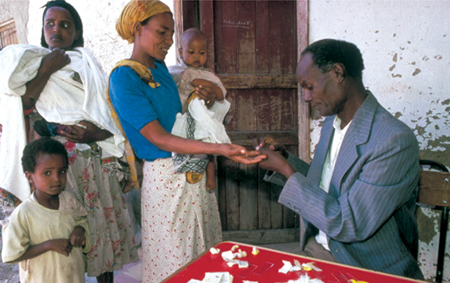3.2 Secondary prevention strategies
Secondary prevention aims to detect new cases of infectious disease at the earliest possible stage and intervene in ways that prevent or reduce the risk of infection spreading further in the population. Some examples of how secondary prevention can be put into practice are described below.
Early treatment
This level of prevention involves infected (or exposed) individuals receiving early treatment to prevent the transmission of pathogens to susceptible hosts. Benefit to the individual may also result from treatment, but the aim from a public health perspective is to protect the community as a whole from further infections, rather than to aid the personal recovery of identified patients.
Education and health-related behaviour modification
Secondary prevention relies partly on educating the population about signs of illness that require prompt referral to the health service, coupled with systematic surveillance to detect and report cases quickly and respond with effective treatment. If the disease has the potential to generate an epidemic, it may be necessary to isolate (quarantine) infected individuals, who should also be educated about how they can prevent or reduce the risk of transmission to others.
Suggest examples of how the education of infected individuals could contribute to the secondary prevention of infection.
Some examples we thought of are:
- People with active TB counselled to cover their mouth when they cough, to avoid coughing close to other people, particularly in enclosed spaces, and to take their medication regularly.
- Pregnant women with HIV counselled about the importance of receiving antiretroviral therapy to reduce the risk of transmitting the virus to their baby.
- People with chlamydia infection counselled about abstinence and safer sex practices to avoid transmitting the bacteria to sexual partners.
Note that even if the condition is not curable by medical treatment, benefit to the community may also result if the education of infected people leads to health-related behaviour modification, i.e. long-lasting changes in behaviour that result in health gains, a reduction in health risks, or an increase in disease prevention. For example, the rates of new HIV infection among gay men in the UK and the USA declined after 1996 due to changes in sexual behaviour, but began rising again after antiretroviral therapy became widely available in high-income countries (CDC, 2001; HPA, 2011c).
Screening
Infected individuals can also be identified even before symptoms develop in systematic screening programmes, i.e. the application of a test or an investigation to large numbers of individuals to identify those at risk of developing a particular disease, or (in the case of infectious disease) those who are already infected. The screening service can target groups assumed to be at high risk; for example, people who are homeless or staying in migrant hostels are at the greatest risk of TB, so TB screening programmes may be directed towards these groups.
Clinical and/or microbiological screening programmes are a vital component of public health initiatives against infectious diseases all over the world, with the aim of secondary prevention as well as the treatment of individuals (Figure 6). If they are coupled with education on prevention among uninfected individuals given the ‘all clear’, screening programmes also contribute to primary prevention.

Secondary prevention is most difficult where the infectious disease either has a prolonged asymptomatic (symptom-free) stage (e.g. for HIV this may last several years after infection), or can exist in an asymptomatic carrier state where the person becomes chronically infected but never develops disease symptoms and acts as a persistent reservoir of infection to others.
Suggest some examples (other than TB, HIV and malaria) that fit these criteria.
Your suggestions may have included viral hepatitis, typhoid, schistosomiasis, lymphatic filariasis, syphilis, chlamydia and gonorrhoea.
